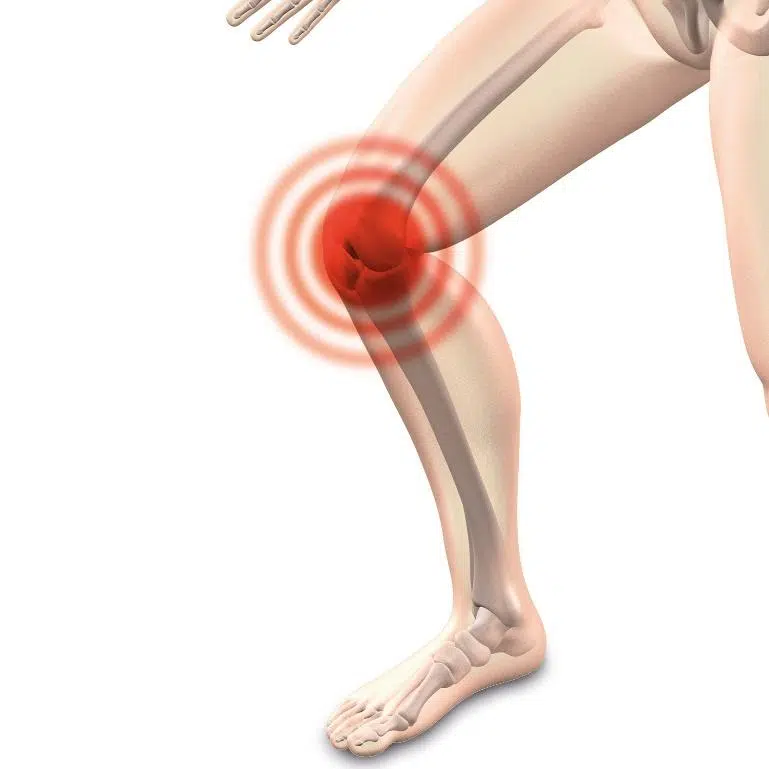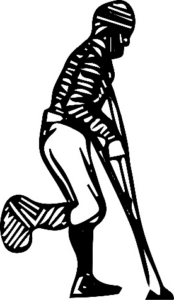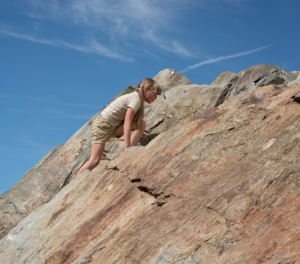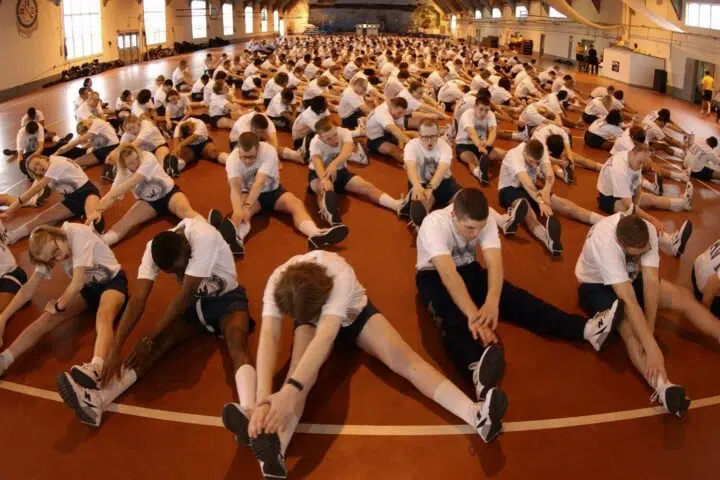Stepping on a bent knee means that the force of each step is being absorbed by the muscles around the knee. Instead of being distributed through your bones.
Heel-to-toe walking is a normal stride when you are going more than a few small steps.
When you take a step, you do not just place your heel down on the ground. This would be a tiny step and take way too long to get anywhere. A normal step starts with extending your leg in front of you. The knee is straight but unlocked, and you take a small fall forward into your heel. Your weight shifts from the back leg and onto the front leg. As your momentum continues to carry you forward the leg shifts behind you and your heel lifts from the ground leaving your toes. Then your leg bends and swings through to take your next heel-to-toe step. Through this motion, your arms are swinging opposite of your legs to counterbalance you and keep your body stable. Your torso rotates with the swinging also. Normal heel-to-toe walking is quite efficient as there is a wind-up and release of energy.
If this process breaks down what happens?
A good way to explain this starts with the anvil test. Laying on your back, raise your leg about 30 degrees, and have someone hit your heel. If your knee is straight, the force should transfer through your heel up your leg to your hips and spine. (Technically it is a test for hip problems). Now try this test again, with your knee slightly bent. The force winds up being mostly absorbed into the knee. So essentially 2-3x your body weight is being transferred through your knee with each step. If you are hitting 10,000 steps, 5,000 are on each leg. The average US male weighs about 200 lbs.
| 2 x 200 lbs. x 5,000 steps = 2.0 million lbs. / knee / day |
| 2 x 150 lbs. x 5,000 steps = 1.5 million lbs. / knee / day |
| 2 x 125 lbs. x 5,000 steps = 1.25 million lbs. / knee / day |
Losing weight, therefore, has a significant impact on knee pain.
These numbers become the focus of some, and there is no denying the difference in force from 135lbs, to 200lbs is significant. But weight does not simply change because you decide to lose weight. It is also hard to lose weight if your activity level is severely reduced, or you are also dealing with pain. Therefore, losing weight is helpful, and an admirable goal, but not the best place to focus our attention. Especially not as the only focus.
Causes for the heel-to-toe pattern to fail:
- Injury to the back, hip, knee, ankle, foot. – May limit motion or make it painful to bear weight. Pain is good at changing movement patterns, often unconsciously. New patterns put weight where you are not used to, this can cause additional problems.
- Wearing high heels, especially stilettos. – Keeps weight on your toes, limits ankle flexion (dorsiflexion), limits hip extension, and may make it difficult to plant your heel.
- Post-op limitations. – Scar tissue or hardware can limit motion. Can you even straighten your knee?
- Not using crutches for long enough. – If told to use crutches, you should not be walking without them until you can take a normal heel-to-toe step. Dropping the crutches too soon can cause altered movement patterns.
- Pain. – Our brains easily adapt to pain by changing movement patterns, returning to old patterns is not as easy.
- Rigid shoes or orthotics. – Limit motion in your foot. Your arch is your primary shock absorber. Locking it in place means it is no longer working to dampen the ground forces. Also crease protectors, Steel toe/shank.
- Pushing something that you do not want to kick. – A stroller or wheelbarrow in front of you may limit your ability to take a full step.
- Going up a steep incline. – You will limit hip extension, and possibly plantar flexion (toe into the ground).
Why is it important to pattern the knee being straight at the heel strike?
As we showed with the anvil test, having a bent knee at the heel strike increases the force absorbed at the knee instead of distributing it through the bones. When you limp you create new problems by loading areas not used to taking the load. So as quickly as you are able to do so returning to a heel-to-toe gait is important.
Heel Toe Rocking.
- Stand on one foot.
- Raise your other leg in front of you.
- Lean forward and gently fall onto your heel.
- Shift your weight onto the forward leg, and keep your toes on the ground. Pause.
- Raise your toes and shift back onto the back foot.
- Repeat, repeat, repeat, try the other side too.
Keep both legs straight as you shift backward and forwards. You are working on balance and the pattern. When you feel you have the pattern down, try taking the next step instead of rocking back. If you notice the pattern breaks, stop and do heel rocks again.
Creating a habit takes repetition and time. Don’t get frustrated. Keep working.
There are lots of other problems that can affect your walking. Heel rocking is just one way to correct the problem of overloading the muscles at your knee. Try to always walk as close to normal as your body will tolerate. Talk to a provider if you need additional help.
We can help accelerate the healing process and teach you how to break the cycle of pain returning with use. Contact Beyond Wellness, a network of medical providers located in Virginia. 703.272.5469 or www.mybwdoc.com
Author:
Dr. Martin C. Donnelly, DC, CCEP, CKTP, FAKTR-PM, GRASTON Certified.
Images were labeled as free use, no attribution was required from Pixabay.











